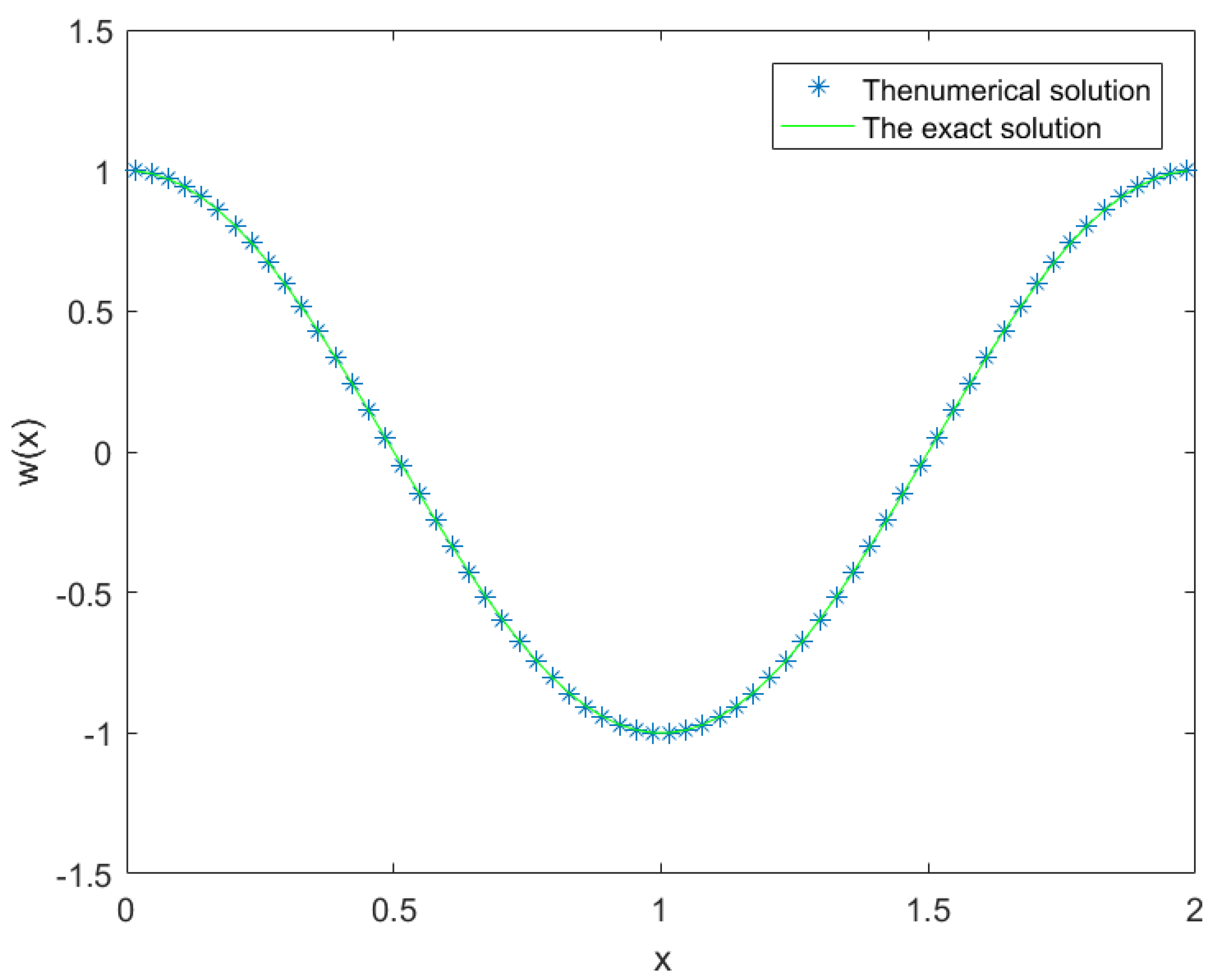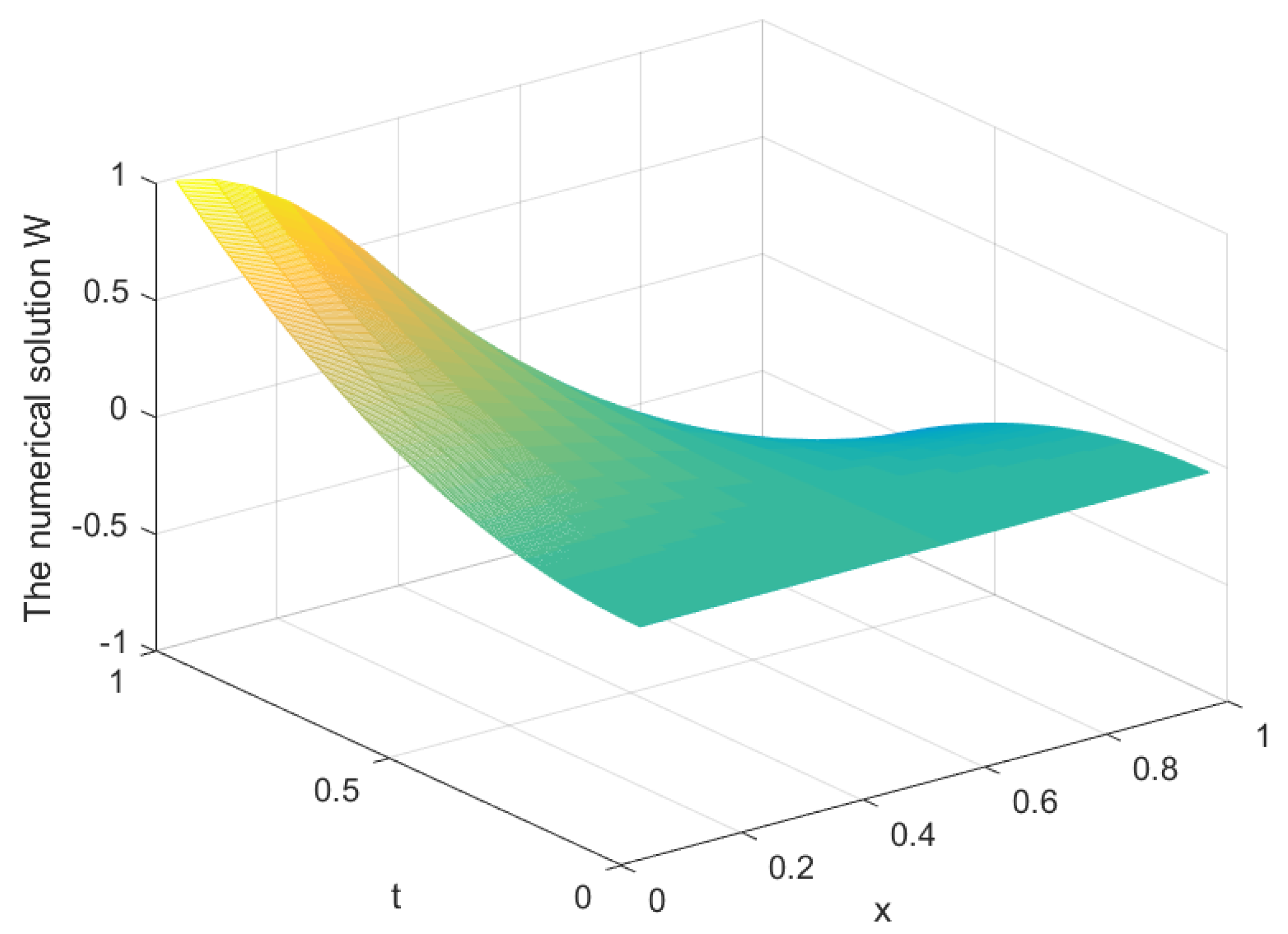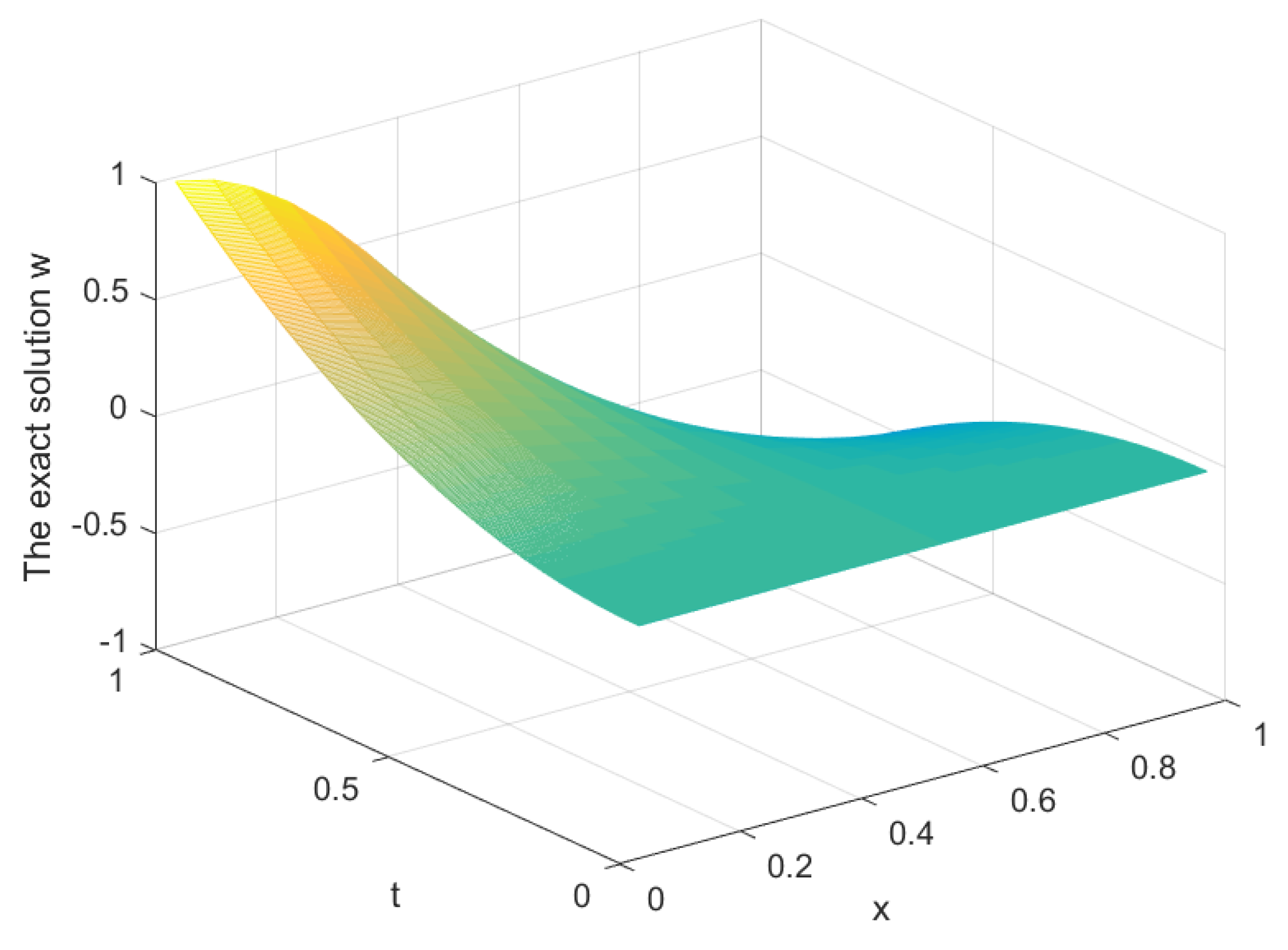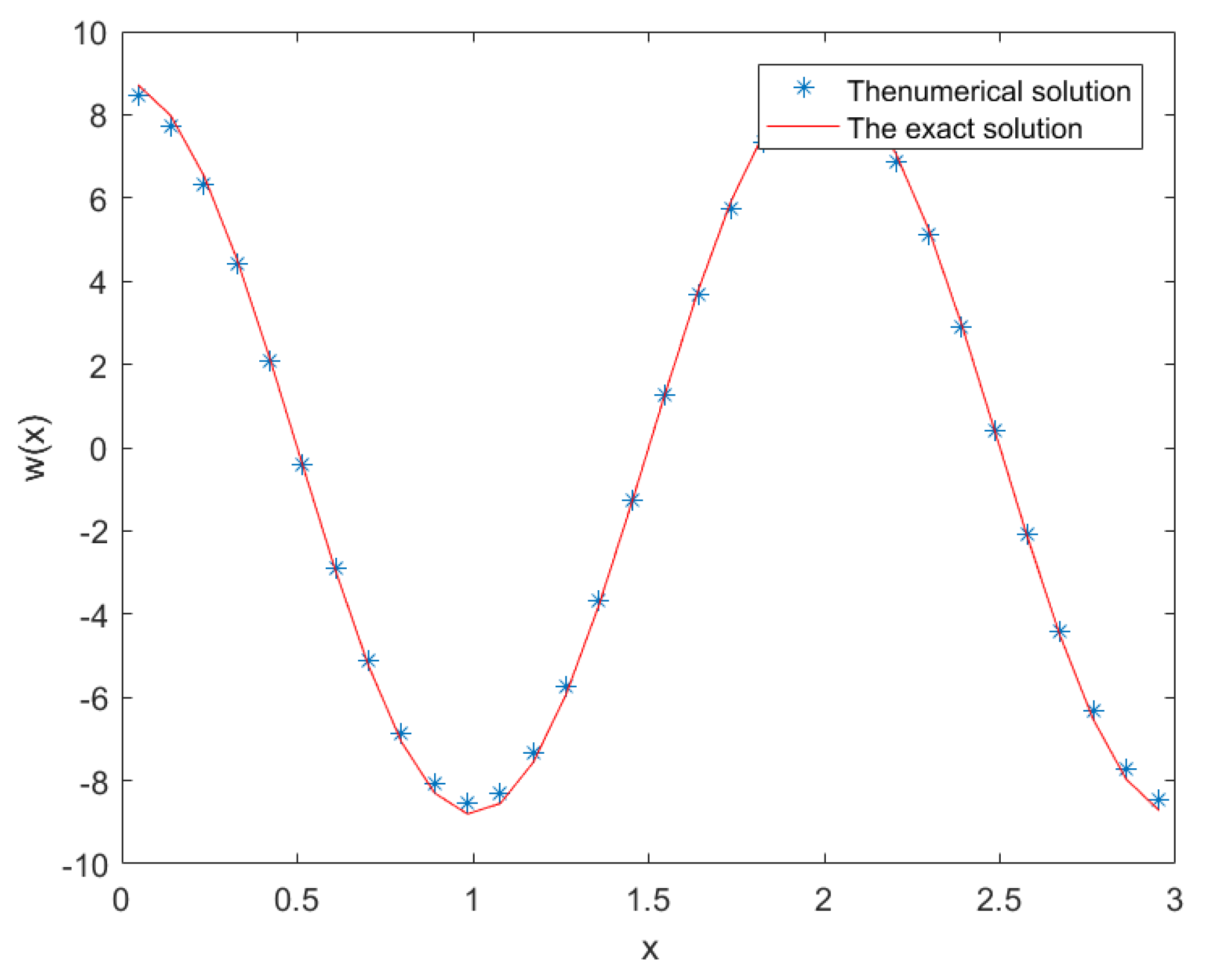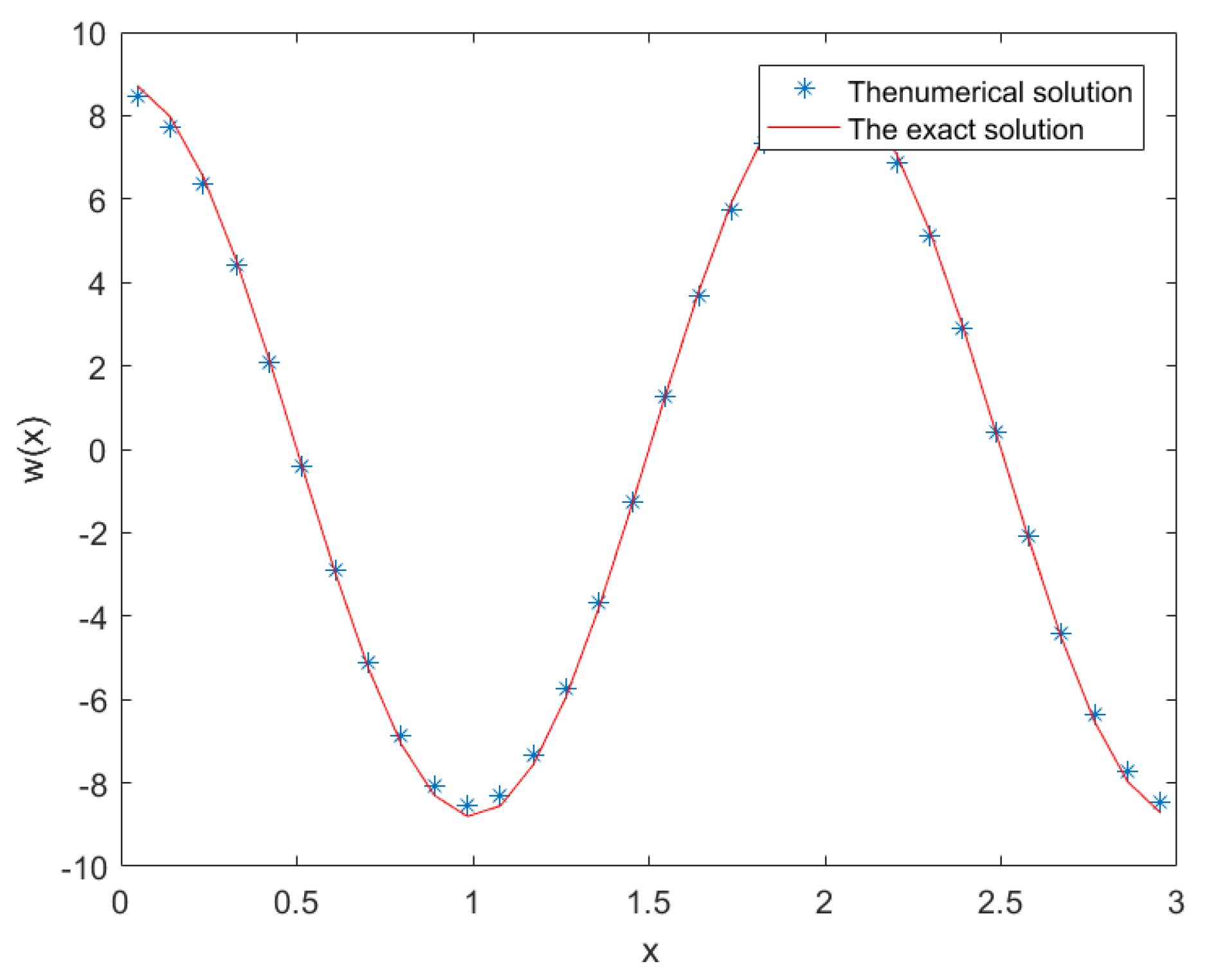1. Introduction
The block-centered finite-difference method was first applied to the simulation of oil reservoirs [
1]. Russell and Wheeler [
1] proved that the block-centered finite-difference method is equivalent to the mixed finite-element method with a special numerical quadrature formula. Based on this equivalence, it is easier to discuss the stability and convergence of the block-centered finite-difference method. In addition, the block-centered finite-difference method can simultaneously approximate the exact solution of the original problem and its derivatives, thus preserving the local conservation of the problem. Moreover, for problems with Neumann boundary conditions, the numerical solution of nodes near the boundary does not need to be considered separately. On this basis, Weiser and Wheeler [
2] introduced the block-centered finite-difference method for linear self-adjoint and non-self-adjoint elliptic and parabolic problems with Neumann boundary conditions in a rectangular area. They proved that the errors of the discrete L2 norms for the solution and the first derivative are both of the second order. Refs. [
3,
4,
5] considered the block-centered finite-difference method for the nonlinear Darcy–Forchheimer equation. The block-centered finite-difference method on non-uniform grids has been discussed in [
6,
7,
8,
9,
10,
11]. In [
12], Ren and Zhang studied the Crank–Nicolson block-centered difference method for solving linear parabolic equations in bounded domains. Li and Rui [
13] introduced and analyzed the block-centered finite-difference method for distributed-order time-fractional diffusion-wave equations with Neumann boundary conditions. In addition, [
14,
15,
16,
17,
18] discussed the two-grid and parallel block-centered finite-difference schemes for parabolic equations and diffusion equations with fractional-order time derivatives. The resulting schemes have a second-order accuracy in space and a
-order accuracy in time, and the unconditional stability and convergence have been proved theoretically. In [
19], Shi and Xie derived and analyzed the fourth-order compact block-centered finite-difference schemes for one-dimensional and two-dimensional variable-coefficient elliptic and parabolic problems. They demonstrated the stability of the solution and flux and performed optimal fourth-order error estimation.
The fourth-order parabolic problem has important practical significance in science and engineering. It can be used to describe bistable phenomena encountered in various fields [
20], such as the competition and spatial sorting of biological populations, migration of riverbeds, charge-density distribution of quantum semiconductors, etc. [
21,
22]. Since the exact solution of the fourth-order equation is difficult to obtain, the numerical method of the fourth-order parabolic equation has attracted extensive attention from researchers in recent years. In [
22], Jüngel studied the positivity-preserving numerical scheme for a class of fourth-order nonlinear parabolic systems in quantum semiconductor modeling and performed transient calculations using a macroscopic quantum model for the first time. The time-fractional derivative is especially good at describing dynamic processes with history dependence; therefore, the time-fractional differential equation can be used to depict physical problems with time variables with great accuracy such as in [
23,
24]. Fractional Caputo derivatives can be used to study the dynamics of plankton–fish models in the presence of toxic compounds produced by harmful algal blooms [
25]. The time-fractional fourth-order parabolic equation can better describe the propagation of waves in intense laser beams and the charge-density distribution of quantum semiconductors. Currently, many researchers are dedicated to the study of fractional-order differential equations. Aziz [
26] studied two inverse source problems of fourth-order parabolic equations with fractional time derivatives. Li and Liao [
27] used a class of
-Galerkin finite-element methods to study the numerical solution of time-fractional nonlinear parabolic problems. They provided the optimal error estimates of several fully discrete linearized Galerkin finite-element methods for solving nonlinear problems. The authors of [
28] established a fully discrete weak Galerkin finite-element method for the initial boundary value problems of two-dimensional sub-diffusion equations with Caputo fractional time derivatives. In [
29], Liu and Du proposed and discussed the finite-difference/finite-element method for solving nonlinear time-fractional fourth-order reaction and diffusion problems. A new implicit compact difference scheme for fourth-order fractional diffuse wave systems was constructed in [
30]. In addition, Ji and Sun [
31] studied the compact algorithm for a class of fourth-order fractional diffusion equations with first-order Dirichlet boundary conditions.
So far, no block-centered finite-difference methods for fourth-order parabolic equations with fractional-order time derivatives have been published in the literature. For the Neumann boundary conditions, which provide the boundary charge density, the time fractional fourth-order parabolic equation is more suitable to be solved using the block-centered finite-difference method, without separately considering the numerical solution of the nodes near the boundary. Therefore, it is of great theoretical and practical significance to propose and develop a block-centered finite-difference method for time-fractional fourth-order parabolic equations. This paper discusses the block-centered finite-difference method [
30] for variable-coefficient fourth-order parabolic equations of fractional-order time derivatives with Neumann boundary conditions. In this method, the mixed finite-element method is used for theoretical analysis, which gives the error analysis a certain regularity. The fractional-order time derivatives are approximated by
interpolation. The block-centered finite-difference scheme is established, and the error estimations of the discrete
norm of the approximate solution and its derivatives are provided. Numerical examples are presented to verify the effectiveness of the block-centered finite-difference scheme.
This paper is organized as follows.
Section 2 introduces the notations used in this paper.
Section 3 presents the block-centered finite-difference scheme and error estimation for fourth-order ordinary differential equations.
Section 4 establishes the block-centered finite-difference schemes for the fractional-order time derivatives and proves the stability and convergence of the schemes. In
Section 5, numerical examples are provided to verify the convergence of the proposed schemes.
2. Notations
We first introduce some notations and definitions used in this paper, which will help with the following analysis. We use notations similar to those in [
2]. Define the partition
of
as
For each
to
N, define
The block-centered dual partition grids are defined as .
Take a positive integer J, and let , .
For any function , let , , donate , , .
Define the following notations
For functions
F and
G, define the midpoint quadrature formula and trapezoidal quadrature formula on
as
and
Given functions
and
, define the
inner product and norm
and the discrete
inner products and norms
Define as the finite-dimensional space of one-dimensional functions that have c continuous derivatives on and are piecewise polynomials of degree d in each interval . When , the functions themselves may be discontinuous.
The notation means that there exists a constant C such that as h approaches zero.
3. Fourth-Order Ordinary Differential Equation
In order to discuss the block-centered difference method for the time-fractional fourth-order parabolic equation, we first consider the block-centered difference scheme for the fourth-order ordinary differential equation.
We consider fourth-order variable-coefficient ordinary differential equations with Neumann boundary conditions
where
is a known smooth function.
The block-centered finite-difference approximations
,
,
, and
to
,
,
, and
, respectively, satisfy the following
which approximate the original Equation (
2). The above block-centered finite-difference scheme can be written as a mixed finite-element scheme with approximate integration
where
,
U and
V are in
, and
P and
W are in
.
Lemma 1 ([
2]).
If is continuous and is in for all i, Proof. By using Equations (
2)–(
6) and the Taylor expansion, we can obtain
According to Equation (
12), the first two terms on the right side of the equation are
. Now, we estimate the third term on the right side.
Similarly, we can reach the same conclusion for V and W by employing the Taylor expansion. □
The second-order error estimation for a block-centered difference scheme applied to fourth-order ordinary differential equations has been derived.
4. Time-Fractional Fourth-Order Parabolic Equation
In this section, we consider the block-centered finite-difference method for a time-fractional fourth-order parabolic equation when .
We consider the following variable-coefficient fractional fourth-order parabolic problem with initial and boundary value conditions
where
is a constant;
,
, and
are known smooth functions; and it is assumed that
.
We consider the case
.
in (
13) is defined as the Caputo fractional derivative of
, which is given by
4.1. Block-Centered Finite-Difference Scheme
In this subsection, we provide the block-centered difference scheme for a time-fractional fourth-order parabolic equation.
Lemma 2 ([
32]).
Suppose , , Lemma 3 ([
32]).
Given that , we have , The block-centered finite-difference method (
13) defines
,
,
and
, satisfying
where
,
,
, and
. Here,
,
,
, and
are approximations to
,
,
, and
, respectively, and
,
,
, and
are their corresponding elliptic projections.
The above block-centered finite-difference scheme can be written as a mixed finite-element scheme with approximate integration
4.2. Stability Analysis
In this subsection, we prove the stability of the scheme (
14)–(
17) when
.
Theorem 1. For the block-centered difference scheme, the following stable inequality holds unconditionally for sufficiently small τ Proof. For
, by multiplying (
14) by
and summing on
i from 1 to
N, we obtain
. So,
where
. Using the Cauchy–Schwarz inequality and Young inequality, we can obtain
For , we suppose that the stability conclusion of the difference scheme is valid when .
Then, by multiplying (
14) by
and summing on
i from 1 to
N, we can obtain
. So,
Using the Cauchy–Schwarz inequality and Young inequality, we obtain
Through mathematical induction and using the relation of coefficient
, we have
There are constants
and
that make
We complete the proof. □
4.3. Error Analysis
The error analysis of the block-centered difference scheme for the time-fractional parabolic equation is performed.
Error estimates for the finite-difference scheme of (
14)–(
17) are derived using a technique of mixed finite-element methods for parabolic partial differential equations.
For fixed
n, let
, and
be defined by
where
,
,
, and
.
Equations (
25)–(
28) can be written as a mixed finite-element method with approximate integration
By the error of the ellipse projection, we have
which hold for sufficiently smooth
w.
By differentiating
t in Equations (
25)–(
28), we can obtain the following estimation
Set , , , , and
By subtracting (
25) from (
14), we obtain
By subtracting (
26), (
27) and (
28) from (
15), (
16) and (
17), respectively, we obtain
By multiplying (
35) by
and summing on
i from 1 to
N, we deduce that
By (
36)–(
38), and Lemma 2, we have
Let
, and (
39) can be written as
By the Cauchy–Schwarz inequality and Young inequality, we have
According to the definition of the fractional derivative and Equation (
34),
Notice that
. Using Theorem 1 and the inductive hypothesis, we deduce that
By multiplying (
35) by
and summing on
i from 1 to
N, we can obtain
By using (
36)–(
38), and Lemma 2, we derive
By substituting (
49)–(
51) into (
48), (
48) can be deformable to
By the Cauchy–Schwarz inequality, we derive
Similarly, when
, using the above mathematical induction and substituting (
44) and (
47) into (
53), we can obtain
By (
33) and the triangle inequality,
which hold for sufficiently smooth
w.
We can draw the following conclusion.
Theorem 2. Let w be sufficiently smooth and satisfy (13). If U, P, V, and W satisfy (14)–(17), for all , 